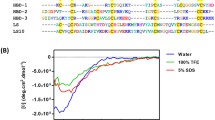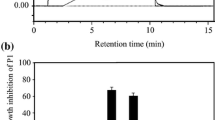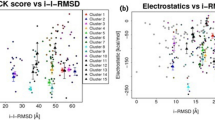Abstract
Antitumor activity is one characteristic function of some certain antimicrobial peptides (AMPs) found in recent years. In the present study, we attempted to detect potential anticancer activity of a recombinant piscidin 5-like from Larimichthys crocea (rLc-P5L) which owned widely antibacterial and strong antiparasitic activity in vitro. The light microscope observation indicated rLc-P5L was of antitumor activity to HeLa cells, 293T cells and L929 cells. MTT assay showed the toxic sensitivity of rLc-P5L to three tumor cell strains was 293T>L929>HeLa. Scanning electron microscope (SEM) results showed rLc-P5L behaved like a lytic peptide to cause damage on cells membrane of L929 cells by forming globular clusters, even pores at 60 µmol/L, or degrading membrane to make it completely lose cytoskeleton structure at 80 µmol/L; rLc-P5L treatment also resulted in DNA degradation. Fluorescence observation results indicated rLc-P5L could cause L929 cells at least two obvious changes: one is nucleus, nuclear chromatin condensed in the margin, nuclear volume became smaller and shrank to be out of shape, or lysed to be debris; the other is cytoskeleton, they became disordered and polarized to make cells atrophic shapes, or even lysed to be debris. In summary, rLc-P5L owned potential anticancer activity causing membrane structure damage and genome DNA degradation. Interestingly, treatment with different concentration of rLc-P5L seemingly caused the similar but different changes, whether it indeed gave rise to cancer cells diverse death way, the further studies should be performed, and the detailed mechanisms were still need further explored.
Similar content being viewed by others
References
Al-Hajj M, Clarke M F. 2004. Self-renewal and solid tumor stem cells. Oncogene, 23(43): 7274–7282, doi: https://doi.org/10.1038/sj.onc.1207947
Chen H C, Brown J H, Morell J L, et al. 1988. Synthetic magainin analogues with improved antimicrobial activity. FEBS Letters, 236(2): 462–466, doi: https://doi.org/10.1016/0014-5793(88)80077-2
Chen H M, Leung K W, Thakur N N, et al. 2003. Distinguishing between different pathways of bilayer disruption by the related antimicrobial peptides cecropin B, B1 and B3. European Journal of Biochemistry, 270(5): 911–920, doi: https://doi.org/10.1046/j.1432-1033.2003.03451.x
Chen Jinguo, Xu Xueming, Underhill C B, et al. 2005. Tachyplesin activates the classic complement pathway to kill tumor cells. Cancer Research, 65(11): 4614–4622, doi: https://doi.org/10.1158/0008-5472.CAN-04-2253
Cheng Linyou, Wang Chunguang, Liu Haizhou, et al. 2012. A novel polypeptide extracted from Ciona savignyi induces apoptosis through a mitochondrial-mediated pathway in human colorectal carcinoma cells. Clinical Colorectal Cancer, 11(3): 207–214, doi: https://doi.org/10.1016/j.clcc.2012.01.002
Dennis J W. 1991. N-linked oligosaccharide processing and tumor cell biology. Seminars in Cancer Biology, 2(6): 411–420
Dobrzyñska I, Szachowicz-Petelska B, Sulkowski S, et al. 2005. Changes in electric charge and phospholipids composition in human colorectal cancer cells. Molecular and Cellular Biochemistry, 276(1): 113–119
Doonan F, Cotter T G. 2008. Morphological assessment of apoptosis. Methods, 44(3): 200–204, doi: https://doi.org/10.1016/j.ymeth.2007.11.006
Hancock R E W, Sahl H G. 2006. Antimicrobial and host-defense peptides as new anti-infective therapeutic strategies. Nature Biotechnology, 24(12): 1551–1557, doi: https://doi.org/10.1038/nbt1267
Hilchie A L, Doucette C D, Pinto D M, et al. 2011. Pleurocidin-family cationic antimicrobial peptides are cytolytic for breast carcinoma cells and prevent growth of tumor xenografts. Breast Cancer Research, 13(5): R102, doi: https://doi.org/10.1186/bcr3043
Hoskin D W, Ramamoorthy A. 2008. Studies on anticancer activities of antimicrobial peptides. Biochimica et Biophysica Acta, 1778(2): 357–375, doi: https://doi.org/10.1016/j.bbamem.2007.11.008
Janmaat M L, Rodriguez J A, Jimeno J, et al. 2005. Kahalalide F induces necrosis-like cell death that involves depletion of ErbB3 and inhibition of Akt signaling. Molecular Pharmacology, 68(2): 502–510, doi: https://doi.org/10.1124/mol.105.011361
Lehmann J, Retz M, Sidhu S S, et al. 2006. Antitumor activity of the antimicrobial peptide magainin II against Bladder Cancer Cell Lines. European Urology, 50(1): 141–147, doi: https://doi.org/10.1016/j.eururo.2005.12.043
Lin M C, Lin S B, Chen J C, et al. 2010. Shrimp anti-lipopolysaccharide factor peptide enhances the antitumor activity of cisplatin in vitro and inhibits HeLa cells growth in nude mice. Peptides, 31(6): 1019–1025, doi: https://doi.org/10.1016/j.peptides.2010.02.023
Melino S, Gallo M, Trotta E, et al. 2006. Metal-binding and nuclease activity of an antimicrobial peptide analogue of the salivary histatin 5. Biochemistry, 45(15): 15373–15383
Niu Sufang, Jin Yuan, Xu Xin, et al. 2013. Characterization of a novel piscidin-like antimicrobial peptide from Pseudosciaena crocea and its immune response to Cryptocaryon irritans. Fish & Shellfish Immunology, 35(2): 513–524
Pan Ying, Zheng Libing, Mao Yong, et al. 2019. The antibacterial activity and mechanism analysis of piscidin 5 like from Larimichthys crocea. Developmental & Comparative Immunology, 92: 43–49
Papo N, Seger D, Makovitzki A, et al. 2006. Inhibition of tumor growth and elimination of multiple metastases in human prostate and breast xenografts by systemic inoculation of a host defense-like lytic peptide. Cancer Research, 66(10): 5371–5378, doi: https://doi.org/10.1158/0008-5472.CAN-05-4569
Papo N, Shai Y. 2005. Host defense peptides as new weapons in cancer treatment. Cellular and Molecular Life Sciences, 62(7–8): 784–790
Risso A, Braidot E, Sordano M C, et al. 2002. BMAP-28, an antibiotic peptide of innate immunity, induces cell death through opening of the mitochondrial permeability transition pore. Molecular and Cellular Biology, 22(6): 1926–1935, doi: https://doi.org/10.1128/MCB.22.6.1926-1935.2002
Salger S A, Reading B J, Baltzegar D A, et al. 2011. Molecular characterization of two isoforms of piscidin 4 from the hybrid striped bass (Morone chrysops × Morone saxatilis). Fish & Shellfish Immunology, 30(1): 420–424
Schweizer F. 2009. Cationic amphiphilic peptides with cancer-selective toxicity. European Journal of Pharmacology, 625(1–3): 190–194
Shai Y. 1999. Mechanism of the binding, insertion and destabilization of phospholipid bilayer membranes by α-helical antimicrobial and cell non-selective membrane-lytic peptides. Biochimica et Biophysica Acta: Biomembranes, 1462(1–2): 55–70
Wang Cuicui. 2011. Novel anti-tumor polypeptide from Meretrix meretrix Linnaeus and the underling molecular mechanisms (in Chinese) [dissertation]. Qingdao: Institute of Oceanology, Chinese Academy of Sciences
Wyllie A H. 1980. Glucocorticoid-induced thymocyte apoptosis is associated with endogenous endonuclease activation. Nature, 284(5756): 555–556, doi: https://doi.org/10.1038/284555a0
Xu Hai, Chen Cuixia, Hu Jing, et al. 2013. Dual modes of antitumor action of an amphiphilic peptide A9K. Biomaterials, 34(11): 2731–2737, doi: https://doi.org/10.1016/j.biomaterials.2012.12.039
Zhang Duanwu. 2009. Identification and mechanism of RIP3 as a molecular switch between apoptosis and necrosis (in Chinese) [dissertation]. Xiamen: Xiamen University
Zhao Ruijun, Cheng Jingxia, Dai Peifang, et al. 2007. Effect of antibacterial peptides extracted from musca domestica pupa on membrane of cancer cell. Chinese Journal of Public Health, 23(11): 1399–1400
Zhao Donghong, Zhang Shuangquan, Dai Zhuying, et al. 2000. Studies on the effect of recombined Cecropin CM4 breaking cytoskeleton and nuclear matrix-intermediate of cancer cells. High Technology Letters, 10(1): 23–27
Zheng Libing, Hong Yuequn, Sun Kaihui, et al. 2020. Characteristics delineation of piscidin 5 like from Larimichthys crocea with evidence for the potent antiparasitic activity. Developmental & Comparative Immunology, 113: 103778
Zhou Huamin, Li Dacheng, Wang Yiying, et al. 2018. Antimicrobial peptide Pc-pis: a new cancer cell killer. Fish & Shellfish Immunology, 81: 368–373
Zhou Qijia, Su Yongquan, Niu Sufang, et al. 2014. Discovery and molecular cloning of piscidin-5-like gene from the large yellow croaker (Larimichthys crocea). Fish & Shellfish Immunology, 41(2): 417–420
Zhu Weiquan, Chen Jinghai, Cong Xiangfeng, et al. 2006. Hypoxia and serum deprivation-induced apoptosis in mesenchymal stem cells. Stem Cells, 24(2): 416–425, doi: https://doi.org/10.1634/stemcells.2005-0121
Zupkó I, Réthy B, Hohmann J, et al. 2009. Antitumor activity of alkaloids derived from Amaryllidaceae species. In Vivo, 23(1): 41–48
Funding
The National Key R&D Program of China under contract No. 2018YFC1406302; the Zhoushan Science and Technology Special Project under contract No. 2020C21005; the Zhejiang Education Department General Project under contract No. Y201942430; the National Natural Science Foundation of China under contract No. 41606418.
Author information
Authors and Affiliations
Corresponding authors
Rights and permissions
About this article
Cite this article
Zheng, L., Qiu, J., Liu, H. et al. Potential anticancer activity analysis of piscidin 5-like from Larimichthys crocea. Acta Oceanol. Sin. 41, 53–60 (2022). https://doi.org/10.1007/s13131-021-1805-3
Received:
Accepted:
Published:
Issue Date:
DOI: https://doi.org/10.1007/s13131-021-1805-3




